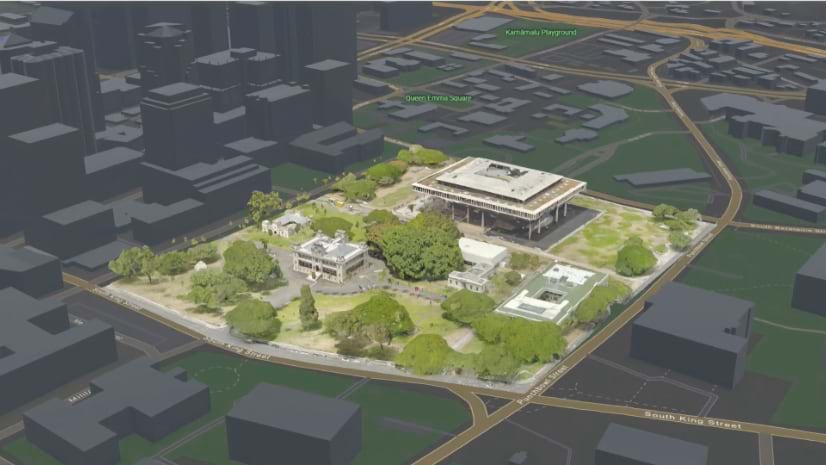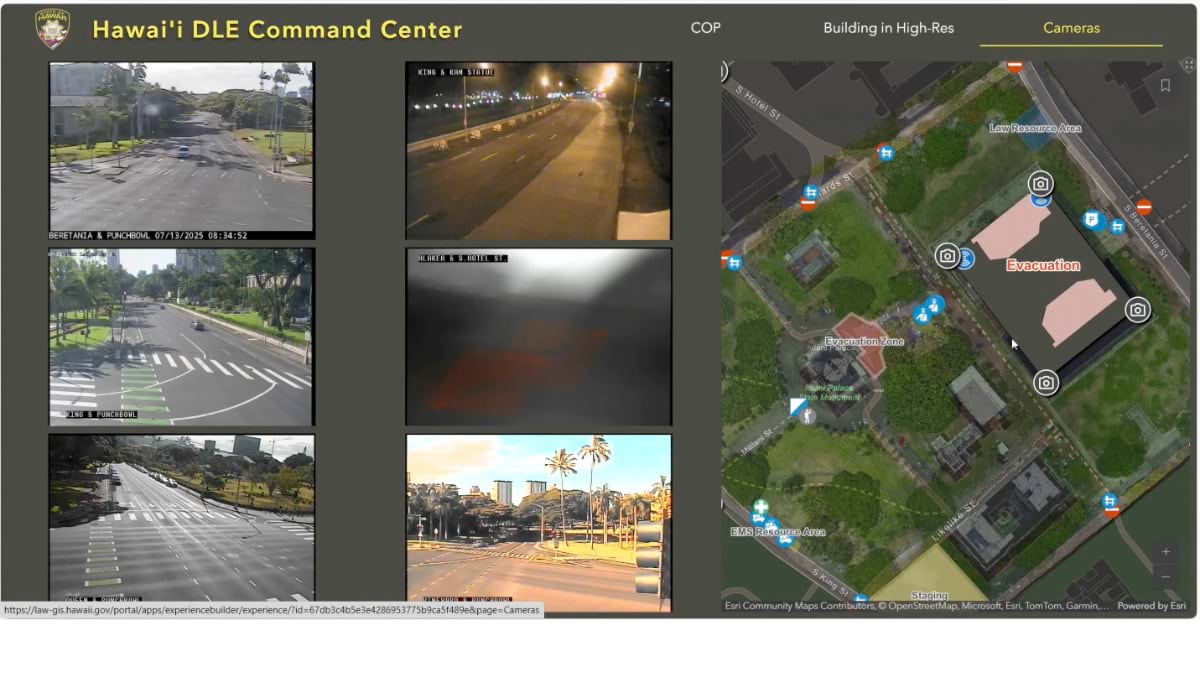
Hawaii’s new state police force is pioneering digital twin technology to solve unique island policing challenges.
Virtual Reality Meets Real Policing: How Hawaii’s Newest State Agency is Protecting Paradise
by John Beck, ESRI, August, 2025
Key Takeaways
- Hawaii’s digital twin technology has been used to secure the state capitol and coordinate law enforcement operations across multiple islands.
- Digital twin technology helps address recruitment challenges by appealing to younger candidates.
- New recruits train using VR headsets to work together without traveling from remote islands.
Brandon Asuka had a revelation while playing video games. As the executive officer for the State of Hawaii Department of Law Enforcement watched immersive digital environments unfold on his screen, he wondered: What if we could bring that same technology to modern policing?
“Playing video games has helped me see what can happen in reality,” Asuka said. “I wanted to see if we could apply policing tactics in a virtual world to train teams and test strategy.”
That vision has become reality. Hawaii’s Department of Law Enforcement is now pioneering the use of virtual reality—using geographic information system (GIS) technology to build a geospatial digital twin—to enhance security and situational awareness. They leverage the virtual representation of reality to protect Hawaii’s state capitol, one of the nation’s most accessible government buildings, and address the unique challenges of policing across multiple islands.
Building America’s Last State Police Force
Hawaii holds a distinctive place in American law enforcement history. It was the only state without a dedicated state police force until 2023. Its Department of Law Enforcement emerged from a legislative effort to consolidate law enforcement functions under a single cabinet-level director.
“Whenever there was a critical incident, there would be multiple chiefs that had to respond, and there was no true decision-maker,” Asuka said. The consolidation streamlined the command structure where Governor Josh Green could turn to one law enforcement director—Mike Lambert—for all state-level public safety issues.
Lambert, a 21-year veteran of the Honolulu Police Department with experience ranging from narcotics to community outreach, brought a wealth of expertise to building the department. His background in narcotics and vice investigations, combined with his understanding of Hawaii’s unique security challenges, positioned him to lead an agency that could learn lessons from other states while embracing innovative approaches.
Starting fresh also allowed the department to make strategic technology investments from day one.
“The legislature gave us a significant budget to invest in technology,” Asuka said, “and part of the early stages was going to other law enforcement agencies to see what they’ve done, what was available, the mistakes they’ve made and how we could potentially avoid those.”
Open Access at the Capitol
The Hawaii State Capitol presents a unique security challenge. It opened in 1969 with a statutory requirement to be surrounded by water, carried out as reflecting pools, to symbolically reflect the islands. The building also maintains an open-access philosophy, one that often clashes with modern security realities.
“We have the most accessible capitol in the nation by far. It’s the one place you don’t have to put your bags through X-ray machines,” Asuka said. Visitors pass through minimal metal detection and aren’t asked about their destinations. The legislature maintains that it’s “the people’s building,” prioritizing public access over security restrictions.

The Hawaii State Capitol digital twin displays stunning photorealistic detail captured through drone flights and 360-degree cameras. The GIS-based system allows law enforcement to explore multiple data layers for security planning and emergency response scenarios.Slide 1Slide 2Slide 3
But as political tensions escalate nationwide, Hawaii faces new challenges. While actual threats remain limited, the perceived threat level has increased, with some legislators requesting 24-hour security details and panic buttons following social media threats.
“For elected officials, it’s mostly the perceived threat,” Asuka said. “When someone online says, ‘I’m going to kill you over this vote,’ legislators take that seriously.”
This is where digital twin technology offers a sophisticated solution, allowing the department to enhance security while maintaining the capitol’s welcoming atmosphere.
Virtual Reality Meets Real-World Response
The digital twin of Hawaii’s state capitol is a detailed virtual replica that integrates live camera feeds, IoT sensors, and real-time data streams. Using Meta Quest VR headsets, law enforcement officials can navigate through the building virtually, observing actual conditions without their physical presence.
“We use the Meta 3 goggles to fly around in our digital twin right now at the state capitol,” Asuka said. The technology serves multiple purposes: training simulation, emergency planning, and real-time situational awareness during critical incidents.
For emergency response, the system transforms how administrators manage crises. “Upon alert of an emergency, all they do is put the goggles on and they see what’s happening firsthand at the scene without having to traverse anywhere,” Asuka said. “Having immediate access on the scene is, as an administrator, a lot better than having to worry about traveling to a destination.”
Lambert has emphasized how this technology enhances operational awareness beyond traditional security measures. “When integrated with detection hardware, it can increase an operator’s awareness of movement patterns and identify security weaknesses,” Lambert said, noting that the virtual models enable comprehensive scenario planning and forensic reconstruction capabilities.
The system is currently modeling evacuation routes for the governor and lieutenant governor, including separate protocols for executive protection teams and staff members. The digital twin helps coordinate seating arrangements in legislative chambers and optimize emergency response procedures—all without disrupting daily operations or revealing security measures to potential threats.
Island-Hopping Training Revolution
Hawaii’s geography creates unique logistical challenges for law enforcement training. With officers spread across four of the eight main islands and only 350 sworn personnel covering the entire state, traditional training methods are costly and inefficient.
The digital twin technology solves this problem by enabling virtual collaboration. “A lot of times when we have big events we don’t have enough staff on a single island, but we wouldn’t be able to fly people 12 weeks in advance to train,” Asuka said. “Having a virtual environment allows us to train and be able to do simulations across the islands without having to fly there.”

The Hawaii Department of Law Enforcement's command center integrates live camera feeds with the digital twin, showing evacuation zones, law enforcement staging areas, and EMS resource locations. Officers can access real-time surveillance while coordinating emergency response from a unified dashboard.Slide 1Slide 2Slide 3Slide 4Slide 5
The benefits extend beyond cost savings to broader training applications. “We want to be able to conduct training that could include multiple personnel that are geographically separated using virtual environments,” Asuka said. Officers can practice complex scenarios virtually from their hometowns, then execute coordinated responses when needed for actual events.
Gaming Culture Meets Recruitment Crisis
Hawaii’s Department of Law Enforcement also sees digital twin technology as a recruitment tool. “Young people aren’t going into policing these days,” Asuka said, citing the impact of high-profile incidents and increased scrutiny on law enforcement.
The gaming-inspired technology appeals directly to potential recruits. “It attracts a younger generation that grew up playing video games. It helps show how we solve crimes with technology, with less brute force than in the past,” Asuka said.
This strategy addresses a nationwide policing crisis, positioning the department as an innovative employer that values technological sophistication.
Plans for digital twins in Hawaii include creating a comprehensive virtual model of a square mile in Waikiki—Hawaii’s premier tourism district that generates approximately 30 percent of the state’s revenue.
Working with the Waikiki Business Improvement District, the department aims to integrate hotels, vendors, and businesses into a coordinated security network. “We’re looking at how we use the digital twin technology, different types of IoT sensors in the area, drones, and cameras to be able to create an experience that people want to return to on an annual basis,” Asuka said.
The goal mirrors successful models in Las Vegas and Miami Beach where comprehensive surveillance and coordinated law enforcement create safe tourism environments. “Pretty much if you’re going to commit a crime, just don’t do it here because you’re going to get caught,” Asuka said of the intended message.
Managing Innovation and Perception
Lambert has made transparency a priority in implementing new technologies. “The director is always in the media explaining why we’re using technology and then what the long-term use cases are going to be,” Asuka said. This proactive approach helps manage public perception during an era of heightened scrutiny around police technology adoption.
The department has navigated potential controversies by focusing on clearly beneficial applications like digital twins while avoiding more sensitive technologies like facial recognition. The strategy maintains both community trust and operational effectiveness.
As Hawaii continues to develop its digital twin capabilities, other jurisdictions are watching. The combination of gaming-inspired technology, cross-island training, and comprehensive situational awareness offers a compelling model for modern law enforcement—one that prioritizes innovation, efficiency, and community safety in equal measure.
For a state that was the last to establish a state police force, Hawaii is now positioning itself at the forefront of law enforcement technology, proving that sometimes the newest approaches can be the most effective.
Learn more about how police departments use GIS to apply spatial analysis to crime trends in their jurisdictions to determine where and when to deploy resources to have the greatest impact on crime.